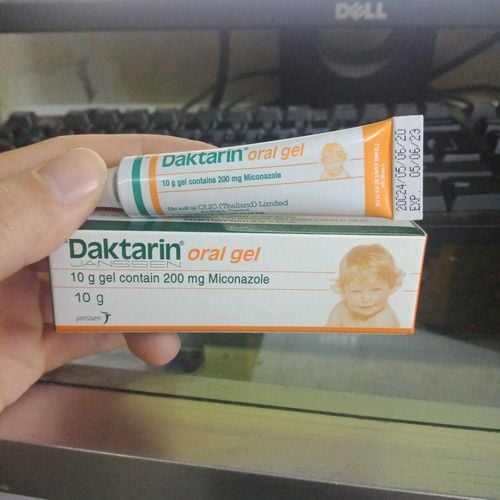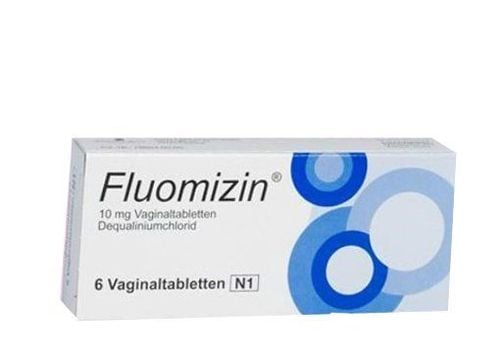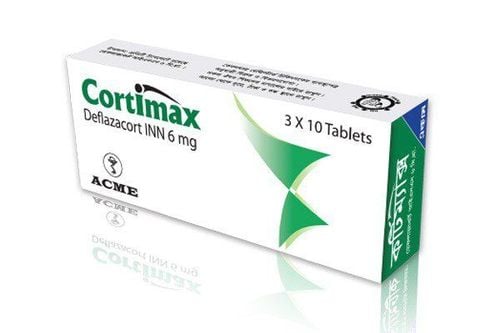This is an automatically translated article.
Ifatrax medicine has the main ingredient Itraconazole, used in the treatment of fungal infections. Complying with the indications and doses of Ifatrax will help patients improve treatment efficiency and ensure safety for health.1. What is Ifatrax?
Ifatrax belongs to the group of drugs against infections, viruses, fungi, parasites. Ifatrax has the active ingredient Itraconazole (in the form of microparticles containing Itraconazole 22% kl/kl).
Dosage form: Hard capsule, each containing 100mg Itraconazole and excipients just enough.
Packing form: Box of 1 blister x 4 capsules.
2. What does Tfatrax do?
Pharmacodynamics:
Itraconazole is classified as a systemic antifungal drug. Itraconazole has better antifungal activity than Ketoconazole against some fungi such as Aspergillus. It is also active against Cryprococcus, Coccidioides, Histoplasma, Blastomyces, Sporotrichosis, Candida. Itraconazole inhibits fungal cell survival and growth. In vitro studies have shown that some clinically isolated fungi (including Candida) that are less susceptible to one Azol antifungal agent are similarly susceptible to other Azol derivatives. The susceptibility of fungi to Itraconazole depends on the inoculum size, incubation temperature, culture medium, and growth stage of the fungus. Pharmacokinetics:
Absorption: When taken with or after meals, Itraconazole is better absorbed because food increases absorption. The solubility of Itraconazole is higher in acidic media. The absolute bioavailability of Itraconazole is approximately 55%, which is maximal when taken after a nutritious meal. Distribution: Itraconazole is highly bound to plasma proteins, the binding rate is 99% - 99.8%, mainly to albumin. Itraconazole is well soluble in fat, with higher concentrations in body tissues than in serum. Concentrations in lungs, stomach, liver, bones, spleen, muscles... are 2-3 times higher than in plasma. Metabolism: The liver is the site of metabolism of Itraconazole. Here, Itraconazole is metabolized into many different substances, which are then eliminated in the feces and urine. Elimination: Itraconazole is eliminated as an inactive metabolite in the urine (35%) and feces (54%). The parent drug is excreted by the kidneys less than 0.03% of the dose, while that in the faeces is 3 - 18%. Itraconazole is well absorbed by the horny tissues, especially the skin, 4 times higher than in plasma and the elimination of Itraconazole is related to skin regeneration. Plasma concentrations are undetectable 7 days after discontinuation of the drug, but can be detected in the skin after 2-4 weeks of 4-week treatment with Itraconazole. Itraconazole was detected in the skin after 1 week of treatment and was maintained for at least 6 months thereafter during a 3-month course of treatment.
3. Indications and contraindications of Ifatrax
Ifatrax is indicated in the following cases:
Candida infections in the mouth, throat, vulva, vagina; Wanderlust; Dermatophytes sensitive to Itraconazole (Trichophyton, Microsynrum, Epidermophyton floccosum); Fungal infections of toenails and hands; Histoplasmosis causes chronic disease in the lung cavity and scattered Histoplasmosis, excluding meninges; Pulmonary and extrapulmonary aspergillosis in patients intolerant to or resistant to amphotericin B; Prevention of recurrence of latent fungal infections in AIDS patients. Ifatrax is contraindicated in the following cases:
Allergy to any component of Ifatrax drug; Pregnant and lactating women. Use only in case of life-threatening visceral fungal infections and the potential benefits outweigh the risks to the fetus; Patients with ventricular dysfunction, except in life-threatening cases; The patient is taking the following drugs: Astermizol, Cisapride, Terfenadin, Triazolam and Oral Midazolam.
4. Dosage and how to take Ifatrax
Always follow your doctor's instructions for Ifatrax, absolutely do not change the dosage and route of medication on your own, and do not give this medicine to others even if they have the same symptoms as you. .
Dosage:
Vaginal candidiasis: 1 tablet/time x 2 times/day or 2 tablets/time/day, used for 1-3 days; Oropharyngeal candidiasis: 1 tablet/day x 15 days; Ringworm : 2 tablets / time / day, drink for 7 days; Skin thrush, inguinal fungus: 1 tablet/day x 15 days or 2 tablets/day x 7 days; Toenail fungus: 1 tablet/day x 30 days; Toenail fungus: need to be treated 2-3 times, each session lasts 7 days, do not use medication between sessions 3 weeks apart, 4 tablets a day divided into 2 times in the morning and afternoon. Or can be treated continuously 2 tablets / time / day continuously for 3 months; Visceral fungi: Aspergillus: 2 tablets/time/day, taken for 2-5 months, increase the dose to 2 tablets/time x 2 times/day if the disease is widespread; Candida: 1-2 tablets/time/day, take from 3 weeks to 7 months; Epidural Cryptococcus: 2 tablets/time/day, taken from 2 months to 1 year; Cryptococcal meningitis: 1 tablet/time x 2 times/day, maintenance dose with 2 tablets/time/day; Histoplasma: 2 tablets x 1-2 times/day, taken for 8 months; Sporothrix schenckii: 1 tablet/time/day, taken for 3 months; Paracoccidioides brasiliensis: 1 capsule/time/day, orally for 6 months; Chromomycosis: 1-2 tablets x 1 time/day, taken for 6 months; Blastomyces dermatitidis: 1 tablet / time / day or 1 tablet / time x 2 times / day, taken for 6 months. Directions: Swallow the capsule whole with water, do not chew or crush. For maximum absorption of Ifatrax, it is best to take it after meals.
What to do if you miss a dose of Ifatrax ?
Take another dose as soon as you remember. However, if it is almost time for your next dose, skip the missed dose and take the next dose as directed. Do not take 2 doses at the same time to make up for a missed dose. What should you do if you overdose on Ifatrax?
Not much information on drug overdose has been recorded. Some patients taking doses above 1000 mg have experienced symptoms similar to those occurring at the recommended dose. In case of overdose, the patient should immediately stop taking the drug and go to the nearest medical facility for treatment, bring all the medicines you are using, including prescription and non-prescription drugs. Within 1 hour of overdose, the patient can be gastric lavage or activated charcoal can be used. Currently, there is no specific antidote to Ifatrax, treatment is mainly symptomatic and supportive.
5. Undesirable effects when using ifatrax
During the use of Ifatrax, you may encounter the following undesirable effects:
Common: Abdominal pain, nausea, rash; Rare: Leukopenia, decreased tactile sensation, visual disturbances, tinnitus, pancreatitis, elevated liver enzymes, urinary urgency, fever; Uncommon: Hypersensitivity, headache, dizziness, paresthesia, vomiting, diarrhea, constipation, dyspepsia, dysgeusia, flatulence, hyperbilirubinemia, increased alanine aminotransferase, increased aspartate aminotransferase, urticaria, alopecia hair, itching, edema, menstrual disorders; Frequency not known: Neutropenia, thrombocytopenia, anaphylaxis, anaphylactoid reactions, angioedema, serum sickness, hypokalemia, hypertriglyceridemia, peripheral neuropathy, blurred vision and diplopia, transient or permanent hearing loss, congestive heart failure, pulmonary edema, acute liver failure, hepatitis, hepatotoxicity, toxic epidermal necrolysis, Stevens-Johnson syndrome, erythema multiforme , photosensitivity, muscle pain, joint pain, erectile dysfunction, urinary incontinence. Please notify your doctor or pharmacist when you have any unusual symptoms while taking the drug for advice and guidance.
6. Drug interactions
Drugs that can interact with Ifatrax:
Drugs that reduce stomach acid; Rifampicin; Rifabutin; Phenytoin; Ritonavir; Indinavir; Clarithromycin; Erythromycin . The following drugs should not be used with I fatrax:
Astemizol, Bepridil, Cisaprid, Dofetilid, Levacetylmethadol, Mizolastin, Terfenadin; Sertindol, Quinidine, Pimozide, Atorvastatin, Lovastatin, Simvastatin, Triazolam; Sidazolam, Dihydroergotamine, Ergometrin, Ergotamine, Methylergomehin, Eletriptan, Nisoldipine.
7. Some notes when using Ifatrax
Pregnancy: Animal studies have shown that I fatrax has reproductive toxicity. Therefore, this drug should not be used during pregnancy, unless a fungal infection is life-threatening and the potential benefit outweighs the potential risk to the fetus.
Lactation: Itraconazole is excreted in breast milk in small amounts. Therefore, it is important to weigh the benefits and risks of using Ifatrax while breastfeeding.
Drivers and machine operators, working at height: This drug causes headaches, dizziness, hearing and vision loss. Therefore, caution should be exercised when driving, operating machinery or working at height.
8. Preservation of drugs
Store Ifatrax in a cool, dry place, away from direct light; The drug is best stored at a temperature below 30 degrees Celsius; Keep medicine out of reach of children and pets; Do not leave Ifatrax in places that are too hot or too humid because it will affect the quality of the medicine. Above is information about the uses, dosage and precautions when using Ifatrax medicine. To ensure safety for health and maximize the effectiveness of treatment, patients need to take Ifatrax exactly as directed by their doctor.
Please dial HOTLINE for more information or register for an appointment HERE. Download MyVinmec app to make appointments faster and to manage your bookings easily.













